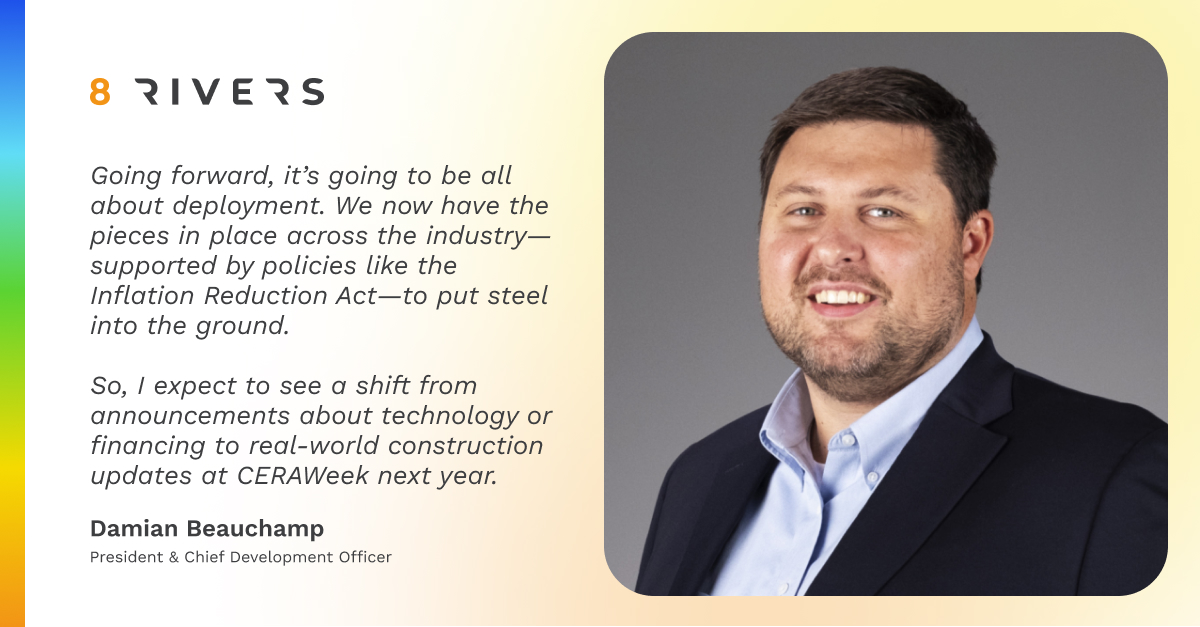The 2024 edition of CERAWeek, one of the most important global energy conferences, was bigger than ever, making our third consecutive year of sponsorship the best yet. Damian Beauchamp, our President and Chief Development Officer, spoke at several sessions and had a front-row seat to the big ideas and conversations that shaped the event.
In this interview, Damian reflects on his CERAWeek experience, how the conference has changed over the 10 years he’s attended, and what he looks forward to next year.

What was your top takeaway from this year’s CERAWeek?
The main thing I left with was the impression that the legacy energy industry is now highly collaborative with the new, climate-positive solutions that are emerging. There was an open-mindedness throughout the entire event and a sense that the energy transition is more opportunity than threat.
This was refreshing and a pretty significant change from past years, when there was much more open skepticism about the value that climate tech had to offer.
So this a shift from the past? What are the ways you’ve seen the mood change in recent years?
CERAWeek has evolved from a pure-play oil-and-gas conference to one that embraces all forms of energy. It provides a fresh take on the idea of the “energy transition” in that many climate-positive solutions are actually extensions of the current industry.
You could see this even in how the event itself is designed. This year, the Agora’s Climate Hub was situated right at the sky bridge that connects the Agora to the Executive Conference, while the Hydrogen Hub was further toward the end of the Agora corridor. This was smart since it ensured that attendees flowing between the Executive Conference and the Agora would engage with the Climate Hub. The Hydrogen Hub naturally draws more foot traffic since it’s already an established industry within the legacy oil and gas space.
This setup ensured that the “energy” around the Agora was incredible. While I spent a good deal of time on the Executive conference side, I frequently found myself drawn back to the Agora for talks or meetings.
Can you mention a few themes that stood out for you?
There was an increased focus on carbon capture as a viable solution. Total announced on the first day of the conference that it acquired carbon storage pioneer Talos, only the latest in a string of developments positioning the oil giants to make major inroads into this space. Alongside this, clean ammonia is growing in importance as a revenue stream for these companies.
One theme that felt quite new was frequent discussions on the massive increase in power demands for artificial intelligence, which seemed to be on every energy executive’s mind this year. We even had the CEO of Accenture and Bill Gates on stage talking about AI and the opportunities it presents to the energy industry, from utilization across the grid to saving time and money for any number of applications.
What do you see on the horizon for the industry over the next year?
Going forward, it’s really going to be all about deployment. A few years ago, the energy transition emerged at the Agora as something to be pursued aggressively and dramatically. That mood has quieted down a bit as people contemplate what it will take to decarbonize in a fair and equitable way, especially in the Global South.
At the same time, we now have the pieces in place across the industry—supported by policies like the Inflation Reduction Act—to put steel into the ground. So, I expect to see a shift from announcements about technology or financing to real-world construction updates at CERAWeek next year.
